From the Editor: On the Radar
Citizen Scientist Participation Requested
On the Trail of the Far Fur Country
Dealing with a Runaway or Breakaway Team of Inuit Dogs
The Chinook Project Returns to Labrador
Website Explores Indigenous People of the Russian Arctic
Book Review: Harnessed to the Pole: Sledge Dogs in Service to American Explorers of the Arctic, 1853-1909
IMHO: What’s Enough?
Navigating This Site
Index of articles by subject
Index of back issues by volume number
Search The Fan Hitch
Articles to download and print
Ordering Ken MacRury's Thesis
Our comprehensive list of resources
Defining the Inuit Dog
Talk to The Fan Hitch
The Fan Hitch home page
Editor: Sue Hamilton
Webmaster: Mark Hamilton
The Fan Hitch, Journal
of the Inuit Sled Dog, is published four
times a year. It is available at no cost
online at: https://thefanhitch.org.
The Fan Hitch welcomes your letters, stories, comments and suggestions. The editorial staff reserves the right to edit submissions used for publication.
Contents of The Fan Hitch are protected by international copyright laws. No photo, drawing or text may be reproduced in any form without written consent. Webmasters please note: written consent is necessary before linking this site to yours! Please forward requests to Sue Hamilton, 55 Town Line Rd., Harwinton, Connecticut 06791, USA or mail@thefanhitch.org.
This site is dedicated to the Inuit Dog as well as related Inuit culture and traditions. It is also home to The Fan Hitch, Journal of the Inuit Sled Dog.
The Fan Hitch welcomes your letters, stories, comments and suggestions. The editorial staff reserves the right to edit submissions used for publication.
Contents of The Fan Hitch are protected by international copyright laws. No photo, drawing or text may be reproduced in any form without written consent. Webmasters please note: written consent is necessary before linking this site to yours! Please forward requests to Sue Hamilton, 55 Town Line Rd., Harwinton, Connecticut 06791, USA or mail@thefanhitch.org.
This site is dedicated to the Inuit Dog as well as related Inuit culture and traditions. It is also home to The Fan Hitch, Journal of the Inuit Sled Dog.
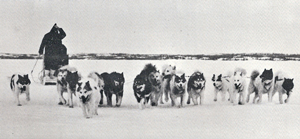
Bill Carpenter training a fifteen dog fan hitch out on
Great Slave Lake, Yellowknife, NWT, Canada
Photo: Andy Steen
Dealing with a Runaway or Breakaway Team of Inuit Dogs
by William J. Carpenter
I don’t know anyone who has driven a team of dogs who has not feared or experienced the loss or near loss of his or her team. During my second visit to Igloolik in 1975 to purchase more dogs and to film a re-enactment of the initial stages of buying Inuit Dogs in 1974 for the Eskimo Dog Recovery Project, and after purchasing a dog from Emile Immaroitok who was about to set off to his spring hunting camp, I saw a case of this first hand. As he started to wave his whip in the air to get his fifteen dogs in fan hitch formation to stand up, suddenly the team began to run forward and it was all he could do to catch up and get onto his komatik. I think he was within a second of losing his entire team.
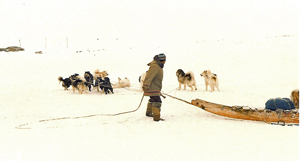
Emile Immaroitok nearly lost his team
Photo: Carpenter
A Runaway Team
My first experience of this was in the spring of 1979 on Great Slave Lake (GSL) as I was training for the planned May trip up north to Resolute Bay with fourteen dogs on the S.M. Hodgson Canadian Eskimo Dog Sledging Expedition, a celebration of the opening of the Prince of Wales Northern Heritage Centre [http://www.pwnhc.ca] and the retirement of Commissioner Hodgson. I had been taking routine 30 km (19 mi) round trips from Yellowknife Bay on GSL to a remote island called Pilot Island. As the island was not visible on the horizon I practiced navigating by the sun to get the correct heading until finally I could see it when the island was about 10 km (6 mi) away.
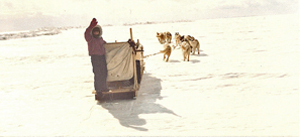 Lara at age 8, driving solo Photo: Carpenter |
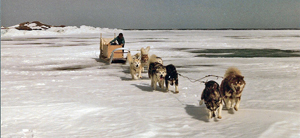 Lara, age 11, driving Inuit Dogs by herself Photo: Carpenter |
On this particular training session was my seven year-old daughter Lara who, since she was about two years-old, accompanied me on many outings. By seven she had driven a small team of dogs on her own. We had just departed the inner Yellowknife Bay with fifteen dogs hooked in a fan hitch going at a brisk pace with them knowing full well the direction of our training trip. Suddenly I inadvertently dropped my Inuit style whip used along with voice commands to help direct the dogs to the left or right. I made the fatal mistake of getting off the komatik to pick up the whip thinking I could retrieve it and then run and jump back onto the komatik. I recovered the whip but could not catch up to the team that had likely picked up speed hauling the lightened load once I stepped off. I managed to yell loud enough for Lara to hear, “Try to get them to turn around with a voice command!” It was to no avail and off she went with a fast moving team of twelve Inuit Dogs.
I started running after them but soon realized there was no hope of catching up, so I headed to the nearby Cominco Mine staff housing site to see if I could get a skidoo to chase after the runaway team with my daughter on the komatik. I was in luck and found a house with a skidoo parked outside. After a brief explanation as to what happened, the woman handed me the keys for the machine. I headed out on the lake to find my daughter and dog team. I soon saw them and after quite a distance I caught up. Pulling up beside the few rear dogs, I aimed the skidoo off to the side while nearly simultaneously hitting the stop engine switch and leaping from the still moving snow machine and onto the komatik. I stopped the dogs by anchoring the snow hook in the hard packed snow. Lara was as calm as could be and told me that on several occasions she almost got the dogs to turn back using voice commands. Although she tried she was much too small to have been able to use the snow hook with any success, so she just rode it out with the runaway team trusting that I would come to the rescue. We decided to leave the skidoo on the lake and give the dogs a longer run rather than go directly back. That proved to be a wrong decision for when we finally headed back to where I left the skidoo a helicopter approached and landed. It was the Royal Canadian Mounted Police (RCMP) Search and Rescue. I knew the officers and the pilot and it turned out they had been called by the woman who owned the skidoo as she was afraid it was very low on gas.
The event ended well and after thanking the RCMP crew we headed back to my truck with Lara driving the team following me on the skidoo. After loading the dogs I returned the machine to its owner and thanked her for all she had done.
Lesson learned: Never get off a moving sledge with an eager to go dog team to pick up a dropped item as there is no guarantee that you will get back on board. What I should have done was stop the team, anchor the snow hook and then pick up the dropped whip.
The Breakaway Team
My second experience of a similar but slightly different nature happened also on GSL in the winter of 1983 (likely February as I recall it was bitterly cold). With my business partner and fellow dog musher, the late John Bayly, we were headed to Moraine Point on the remote west shore of GSL with various supplies and two heavy wood burning heaters to the lodge we owned there.
My daughter Lara, then eleven years-old, was with me and John’s father was with him. The trip always involved one overnight on the lake so on this occasion we decided to leave just after mid day and planned to camp near the West Mirage Islands some 16 km (9.5 mi) out on the lake beyond Yellowknife Bay. I was somewhat behind John as the load I had was heavier and included the two cast iron heaters. The combined weight of the sledge, the heaters, a few camping supplies, food for dogs and humans, survival items plus my daughter and me totaled 500 kg (1100 lb). However, I had a very good strong team of twelve Inuit Dogs hooked in the double tandem (two pairs of six dogs all in a row) and once on the hard packed snow and ice of GSL they pulled the load with ease. I camped by a rocky lichen cover island about 3.5 km (2 mi) from where John camped and in the morning Lara and I took off to meet John and his father who were waiting for us.
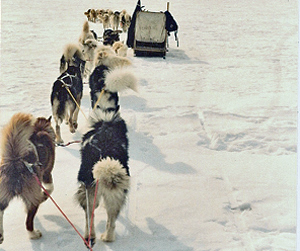
John’s team pulling up to my team. When he passed my front
ten dogs broke away when a wheel dog chewed the gang-line.
Photo: John U. Bayly
That is where the trouble began. No sooner had I stopped our team with an anchored snow hook to take a brief rest when John with his anxious team of eleven (mainly Inuit Dogs), passed mine. One of my wheel dogs, excited by the other team’s pulling ahead, chewed right through the gang-line. With that, my now unrestrained front ten dogs ran forward passing John’s team and headed out on GSL with full knowledge from previous trips of the direction to take. We watched in shock as they continued out on the lake, finally disappearing over the horizon that was 10 km (6 mi) away. At that point we had no idea how far they would go, so we did the next best thing. John hooked his sledge behind mine and we connected his eleven dogs in front of my two remaining dogs. They were now pulling slowly due to the enormous weight of the two sledges. We stopped some distance past the West Mirage Islands, straining our eyes in hopes of spotting my breakaway team. Binoculars offered a better view into the distance and to our complete surprise we saw a small speck on the horizon gradually growing bigger. Lo and behold it was my team returning! We continued to wait and sometime later my ten dogs arrived. The two lead dogs were still out front and all the dogs were completely in a line of five pairs with absolutely no tangles. They arrived all happy and apparently glad to be back with the other dogs. We repaired the gang line, reorganized the dogs and set off once more.
There was one interesting event on the way when we had to cross over a meter-wide crack (or lead) in the ice with open water showing. It was solved quickly when John put a long line on his lead dog and virtually threw him to the other side. Then, tying the line to his gang line the other dogs followed by quickly going in and out of the water while we pushed his sledge easily over the crack. He then threw me a long rope that I tied to my lead dogs. As John moved ahead my dogs were pulled across the crack the same way, with the long sledge easily bridging over the crack and open water.
In view of the unexpected delay of having my ten dogs go missing and then return as they did, we were running behind and knew it would be dark by the time we got to Moraine Point. Fortunately we did have the Coast Guard navigational beacon on the high summit of the point (which via a solar panel even worked in the winter) as a handy aid.
We stayed at Moraine Point for two or three days and then returned to Yellowknife with one overnight stop on GSL near Edgar Point in an old cabin built by fishermen in the mid 1950s.
Lesson learned: One should use a gang line with a wire centre that is bite-proof and cannot be chewed through.
Closing remarks
Those are my only two experiences with losing my dogs. Between 2002 and 2008 while I lived at Moraine Point full time, I had my dogs so well trained they would stop, turn around or come back with a voice command. This was a result of having my Inuit Dogs with me every moment of the day whether loose around the yard, walking them in the forest or on the frozen lake, plus having them in harness daily in the winter.
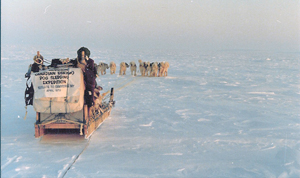
Bill Carpenter and his 14 dog fan hitch participating in the
April 1979 S.M. Hodgson Canadian Eskimo Dog Sledging Expedition
Photo: Carpenter